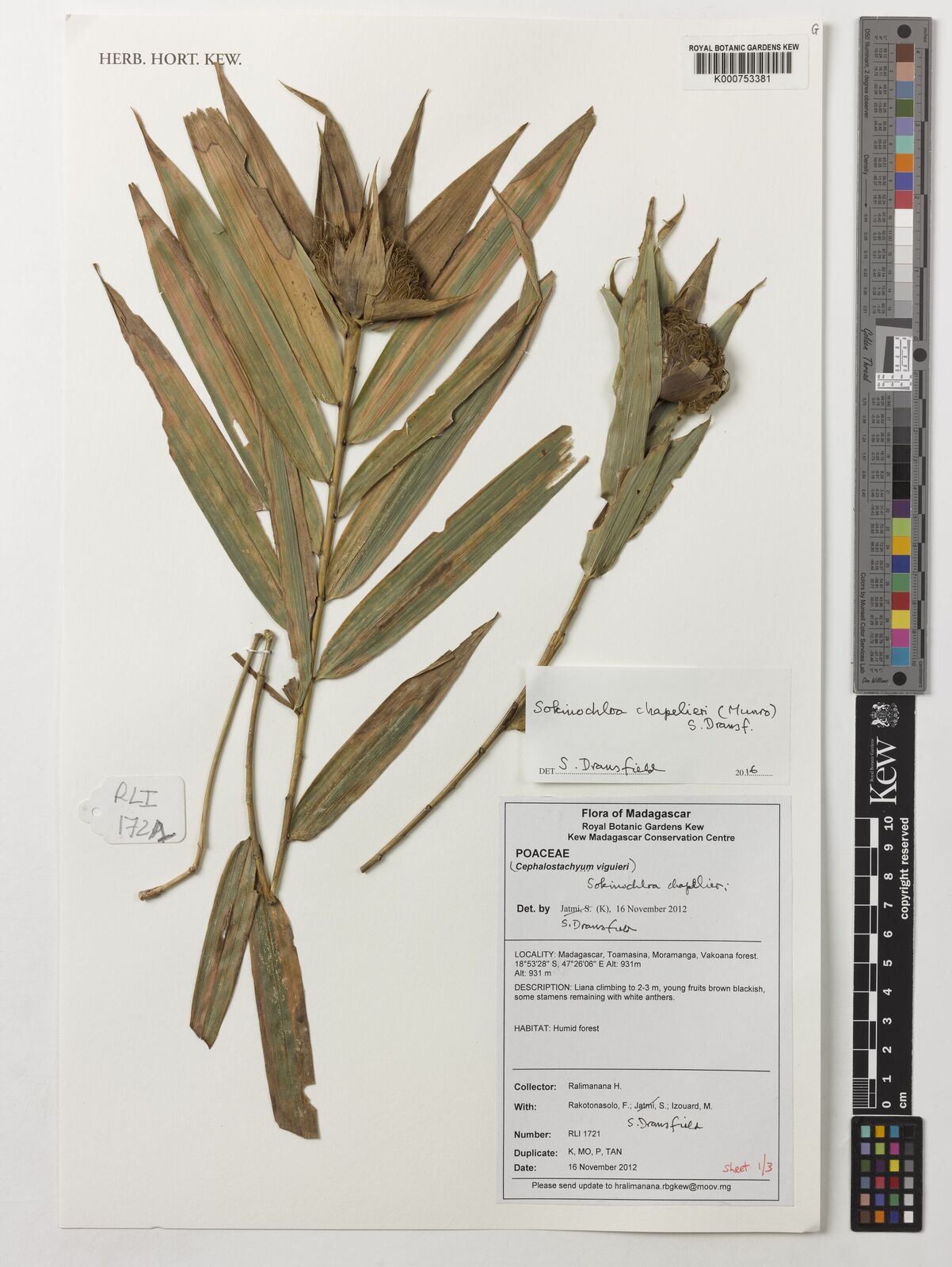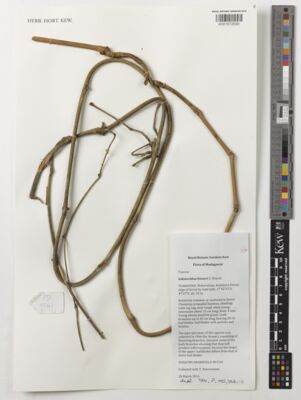Dransfield, S. 2016. Sokinochloa, a new bamboo genus (Poaceae-Bambusoideae) from Madagascar. Kew Bulletin. 71: 40. DOI 10.1007/S12225-016-9650-9
-
Type
-
Type: Sokinochloa australis S. Dransf.
-
Morphology
General
Habit
-
Climbing sympodial, clumping bamboo, culms zigzag or geniculate, solid, internodes smooth or rough, usually glabrous, nodes slightly swollen, curved downwards at one side
-
Morphology
General
Shoots
-
Young shoots glabrous, light green or purplish-tinged
-
Morphology
Branches
-
Non-flowering leafy branches 30 – 60 cm long, bearing 7 to 19 leaf-blades; leaf-blades smooth and glabrous, sheaths glabrous, auricles present or absent; flowering leafy branches 7 – 25 cm long
Branch bud one at each node borne on the curved part of the node; primary branch dominant, dormant or elongating, protruding from the dense clump; secondary branches few at each node
-
Morphology
Reproductive morphology
Inflorescences
-
Inflorescence terminating leafy branch, comprising a determinate capitulum with the presence of subtending sheaths or bracts and the absence of prophylls, the whole rounded and resembling a tenrec (Madagascar hedgehog) or broadly oval, concealed or wrapped in modified leaf-blades, 12 – 35 mm diam., brown or black at maturity, internodes extremely short, each bearing a subtending sheath or bract; sheaths of modified leaf blades densely hairy, blades usually cordate at the base, densely hairy adaxially; subtending sheaths or bracts very broad becoming slender with short or long awns, glabrous or hairy, awns with short or long cilia; 3 or more branches at each node borne on the same base, middle one larger containing one fertile spikelet and two sterile or imperfect spikelets, one at each side of the fertile one, occasionally middle one developing into another branch terminated by a fertile spikelet with 3 or more sterile or imperfect spikelets
-
Morphology
Reproductive morphology
Inflorescences
Spikelets
-
Fertile spikelet consisting of 3 – 6 transitional glumes and one floret, lower glumes slender with long tips or long awns, glabrous, upper ones broader resembling lemma, acuminate or with long tips, glabrous or hairy near the apex; lemma acuminate, upper margins slightly thinner or membranaceous, glabrous; palea slightly grooved on the back or with a sulcus, sulcus glabrous or minutely pubescent, upper part slightly thinner or membranaceous, truncate, often protruding from the lemma at maturity; rachilla extension very much reduced or absent; lodicules present or absent
Sterile or imperfect spikelets subtended by slender bracts with long or short awns and several transitional glumes with short or long awns, with or without empty florets
-
Morphology
Reproductive morphology
Flowers
Androecium
Stamens
-
Stamens 6, filaments free, anthers with blunt or pointed tips
-
Morphology
Reproductive morphology
Flowers
Gynoecium
Ovary
-
Ovary with long style and 3 stigmas
-
Morphology
Reproductive morphology
Fruits
-
Fruit or caryopsis oblong in outline, the top smooth shiny glabrous or pubescent, other parts slightly wrinkled when young.
-
Distribution
-
Endemic to Madagascar.
-
Note
-
The name Sokinochloa was inspired by a remark by one of the guides in Andohahela that it looked like ‘Sokina’, local name for Madagascar Greater Hedgehog.
The genus Sokinochloa is found only in Madagascar. There are four new species and three new combinations in the genus. Three species are found growing in montane forest and the others are found in lowland forest. Those found in montane forest grow together with Decaryochloa diadelpha A. Camus, a scrambling bamboo (Dransfield 1997). The culms in D. diadelpha are erect and more or less straight or slightly zigzag at the base, and can be mistaken for the lower parts of the culms of Sokinochloa species. In D. diadelpha, however, the internodes are usually rough and hairy, the sheaths of the culm sheaths are covered with stiff hairs, auricles are present on culm sheaths and on leaf-blades and are large, bearing very long bristles, whereas in Sokinochloa the internodes are usually smooth or slightly rough and glabrous; the culm sheaths are glabrous and smooth, the auricles are present only on leaf blades, and are narrow and slender with long bristles.
As mentioned above this new genus is not at all related to the Asiatic Cephalostachyum. The structure of the inflorescence of Sokinochloa resembles that of Cathariostachys in being determinate with the presence of subtending bracts or sheaths, and in having one floret in the spikelet. I suggest, therefore, including Sokinochloa in the subtribe Hickeliinae A. Camus (Bamboo Phylogeny Group 2012)
The majority of herbarium collections of all species of Sokinochloa comprise flowering leafy branches only. It seems that Sokinochloa has a gregarious flowering habit. Perhaps each species flowers every 30 – 50 years, and continues flowering over a period of 2 – 3 years, then dies after flowering. During this period non-flowering leafy branches or sterile leafy branches are not produced or found. The shape and dimensions of leaf blades in non-flowering leafy branches are different from that in the flowering leafy branches. The descriptions of leaf blades, therefore, are mainly based on these flowering leafy branches, except for S. viguieri, S. chiataniae, S. australis and S. brachyclada. I collected the last two new species when both non-flowering and flowering leafy branches were available in the same locality, but not from the same plants. In the case of other species I have tried to match my sterile collections with other flowering leafy branches. The key to the species is based mainly on flower structure.
A climbing bamboo genus, differentiated from other bamboo genera in the subtribe Hickeliinae in having capitulate and determinate inflorescences concealed in modified leaf blades, and in the presence of sterile spikelets below the fertile spikelet in the inflorescence, and the presence of awns in the subtending sheaths or bracts.





